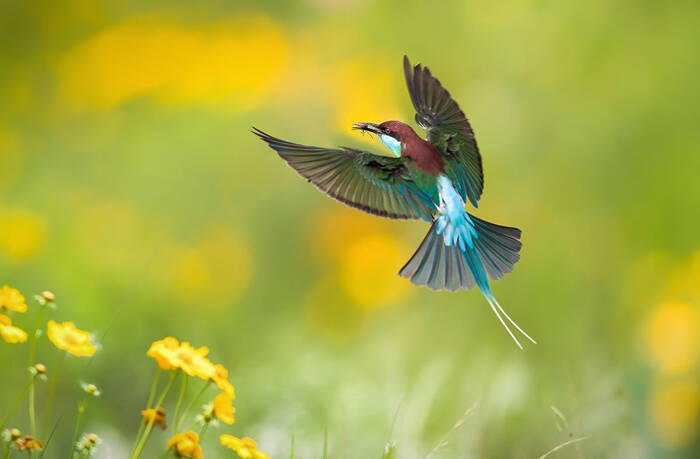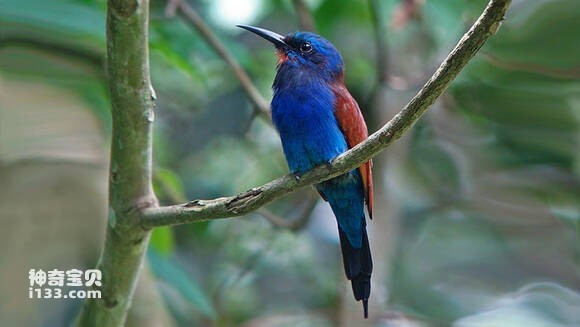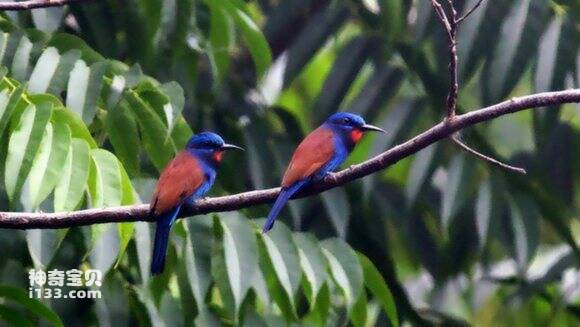Nyctyornis athertoni
IUCN
LCBasic Information
Scientific classification
- name:Nyctyornis athertoni
- Scientific Name:Blue-bearded night bee-eater,Nyctyornis athertoni,Blue-bearded Bee-eater
- Outline:Climbing birds
- Family:order family genus
Vital signs
- length:About 35 cm
- Weight:70-93g
- lifetime:No verification information
Feature
When perched, it constantly raises its tail like an angler
Distribution and Habitat
Distributed in Bangladesh, Bhutan, Cambodia, China, India, Laos, Myanmar, Nepal, Thailand and Vietnam.
Found in mountainous or hilly areas, often in sparse vegetation near or on ridges. From sea level to 1600 meters, it is distributed in dense forests and broad-leaved forests, where it prefers foothills with vegetation with steep slopes, gullies and streams. It is a bird that lives in dense forests. But in dense forests, it generally stays in the middle layer or canopy of forest trees. It is also active on grasslands or hillsides, gullies, rivers, villages, etc. near streams, trails, fallen trees and rock outcrops that appear from time to time.
Appearance
The blue-bearded bee-eater is relatively large, with a body length of 35 cm, a wing length of more than 13 cm, and a weight of 70-93 grams. The feathers in the center of the chest are particularly long and colorful, and the tail is slightly convex and almost the same length as the wings. Summer plumage: The upper body is bright light blue from the forehead to the front of the head, and the rest of the body and the sides of the head and neck, the wings, and the tail surface are grass green with blue. The outer flight feathers have dark brown feather tips and yellow inner edges, and the inner feathers of the side tail feathers have ochre yellow bases and dark brown tips. The lower body from the chin to the sides of the chest is the same color as the back; the center of the throat is light blue, and the center of the front neck to the upper chest (long feathers) turns dark blue; from the lower chest to the lower chest, it is ochre yellow, and except for the lower tail coverts, each feathe
Details
Blue-bearded Bee-eater is a green forest-dwelling bee-eater with two subspecies.

Blue-bearded Bee-eaters live in pairs and seem to be inactive for most of the day. They live high up in the trees, in the shade of leaves, or in the sun near the canopy. They stand next to the inflorescences and will peck at them when nectar is plentiful. When they are perched, they keep lifting their tails like an angler. The species is resident, but some local populations in Nepal and Myanmar migrate seasonally.
The blue-bearded bee-eater sometimes lives on the treetops, and when it sees an insect flying by, it will take off into the air to catch it. Regardless of whether it succeeds or not, it will immediately glide back to its original position in an arc shape; sometimes it hovers above the canopy or flies through the bushes to chase insects, often flying and calling, with a hoarse voice like "ko-r-r: ko-r-r", and when it calls, the long feathers on the throat and chest are significantly loosened.

When the blue-bearded bee-eater is active on trees, it will hold on to the trunk or branches tightly, moving slowly and clumsily, checking the leaves and catching insects. It will also catch some bees that fly to its side. These insects are attracted to the blue-bearded bee-eater because they treat their beards as a flower. The species will bring large insects caught in flight back to its habitat. Not all insects are eaten whole, only the abdomen of large beetles is eaten.
Blue-bearded bee-eaters are insectivorous. They feed on flying insects, mostly bees, mainly 2-3 species of bees and some wasps, the largest of which can sometimes be up to 40 mm long. Among them are cicadas and coleoptera insects, and they also eat weevils, beetles, dragonflies, termites, etc. Even passerine birds and pike have been found in their stomachs.

The global population size of the blue-bearded bee-eater has not been quantified, but the species is reported to be quite common in its range (del Hoyo et al., 2001). The population of the blue-bearded bee-eater is considered stable with no evidence of decline or major threats.
Listed in the IUCN Red List of Threatened Species in 2016 ver3.1 - Least Concern (LC).
Listed in China's "National Key Protected Wildlife List" (February 5, 2021) Level 2.
Protect wildlife and eliminate game.
Maintaining ecological balance is everyone's responsibility!








